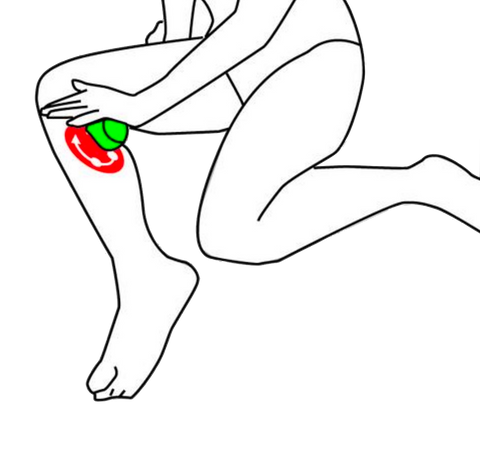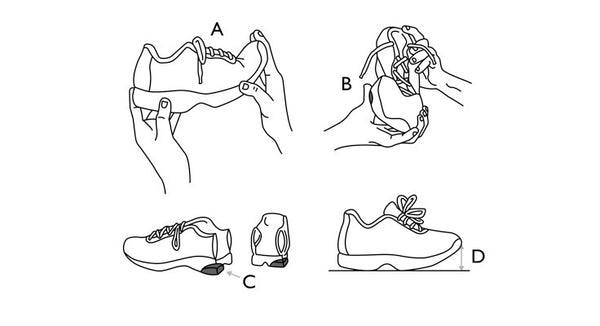Achilles Tendinitis - Self Help
Simple ways to stretch soleus - Stuart Hinds
Become a Trigger Point Therapist
What is Achilles Tendinitis?
Achilles Tendinitis is characterized by an injury to the achilles tendon mostly due to overuse.
The achilles tendon is the largest tendon in the body, connecting your calf muscles to your heel bone. It is used in many activities such as walking, running, and jumping and unfortunately, is commonly injured.
Even though the achilles tendon can withstand the impact caused by running and jumping, it can also be affected by tendinitis, which is associated to overuse, degeneration and injury.
During achilles tendinitis, the tendon responds to an injury or disease with swelling, pain or irritation.
In severe injuries to the achilles tendon, the tendon may tear partially or rupture completely.
Some of the causes of achilles tendinitis are overuse of the achilles tendon, increasing your level of physical activity too quickly and suddenly, wearing high heels, problems with feet such as flat feet, when muscles or tendons in the legs are too tight.
What are the Symptoms of Achilles Tendinitis?
Some of the symptoms of achilles tendinitis are the following:
- Pain along the back of your foot and above your heel
- Pain when stretching your ankle or standing on your toes - Tenderness
- Swelling
- Stiffness
- A snapping or popping sound during the injury
- Difficulties pointing your toes or flexing your foot
The degree of pain will vary depending on the damage to the tendon. Your pain may be mild and worsen gradually if your Achilles Tendinitis is due to overuse or a non-serious injury. If there is a rupture in the tendon, the pain can be abrupt and severe.
Who is Prone to Achilles Tendinitis?
People who participate in the following sports are more likely to suffer form Achilles Tendinitis:
- Running
- Gymnastics
- Dance
- Football
- Baseball
- Softball
- Basketball
- Tennis
- Volleyball
You are more likely to injure or tear an achilles tendon in activities that require you to start moving suddenly. For example, a sprinter might injure his achilles tendon at the start of a race.
Achilles tendinitis is more common in men, especially between the ages of 30 and 50. Men account for about 80% of all achilles tendon ruptures.

TRIGGER POINT SELF HELP
There are many reasons why you might have trigger points, so it is important to consider your trigger point pain in the context of the rest of your body.
It must be stressed that the techniques offered on this page are not a substitute for therapy from a qualified practitioner; although aches and pains from trigger points are common, there can sometimes be an underlying pathology.
It is advisable to always seek a proper diagnosis from a qualified medical practitioner or experienced manual therapist.
Achilles pain is typically associated with trigger points in the gastrocnemius, soleus, and tibialis posterior muscles, all of which act as plantar flexors of the foot.
Try to seek out a "sweet spot" of pain in the calf.
TECHNIQUE:
This technique involves locating the heart of the trigger/tender point.
When this is compressed it may well trigger a specific referred pain map (preferably reproducing your symptoms). This technique involves applying direct, gentle and sustained pressure to the point:
PROCEDURE:
1. Identify the tender/trigger point you wish to work on (see illustration above).
2. Place the host muscle in a comfortable position, where it is relaxed and can undergo full stretch.
3. Apply gentle, gradually increasing pressure to the tender point until you feel resistance. This should be experienced as discomfort and not as pain.
4. Apply sustained pressure until you feel the tender point yield and soften. This can take from a few seconds to several minutes.
5. Steps 3-4 can be repeated, gradually increasing the pressure on the tender/trigger point until it has fully yielded.
6. To achieve a better result, you can try to change the direction of pressure during these repetitions.
STRETCHING

Stretching is an important part of the rehabilitation process and should begin as soon as pain allows and be continued throughout the rehabilitation program and beyond - Good maintenance prevents re-injury.
TECHNIQUE:
-
Begin by standing in front of a step or riser with feet shoulder width apart, facing forward
-
Step up onto the step with both feet, holding on a rail or chair, and letting heels hang off the edge
-
Rising up onto your toes as high as possible in one smooth motion. Hold for a couple seconds
-
Slowly lower heels as far as possible, below the level of the step to complete one rep.
Special Instructions - You can extend your arms out to your sides or lightly rest your fingertips on a wall or chair to help with balance
Make it harder: one-Leg calf raises following the same instructions. Alternate feet after completing one set on each side
HOW OFTEN?
On both legs – repeat 10 x 3 reps each leg
Repeat 30 times, twice daily
TIP:
The more flexible the running shoe, the less stress on the Achilles tendon.

Evaluating Running Shoe Stiffness You can easily evaluate midsole stiffness by twisting your running shoe in several directions while grabbing the heel and forefoot (A and B).
There is a surprising amount of variation in midsole stiffness as running shoes bend with anywhere from 5 to 50 pounds of force. The more flexible the running shoe, the less stress on the Achilles tendon.
The duo-density midsole refers to a softer section of midsole material placed along the outside of the heel (C). The softer outer midsole decelerates the speed the foot pronates during initial ground contact.
Finally, the toe spring of a running shoe refers to the upward angulation of the front of the shoe (D). A high toe spring reduces the length of the lever arm the Achilles has to work against during push-off, thereby reducing strain on the Achilles tendon.
Find a Trigger Point Professional in your area
Dry Needling for Trigger Points
Certify as a Trigger Point Therapist
Recommended Trigger Point Therapy Courses:
This trigger point therapy blog is intended to be used for information purposes only and is not intended to be used for medical diagnosis or treatment or to substitute for a medical diagnosis and/or treatment rendered or prescribed by a physician or competent healthcare professional. This information is designed as educational material, but should not be taken as a recommendation for treatment of any particular person or patient. Always consult your physician if you think you need treatment or if you feel unwell.
About Niel Asher Education
Niel Asher Education (NAT Global Campus) is a globally recognised provider of high-quality professional learning for hands-on health and movement practitioners. Through an extensive catalogue of expert-led online courses, NAT delivers continuing education for massage therapists, supporting both newly qualified and highly experienced professionals with practical, clinically relevant training designed for real-world practice.
Beyond massage therapy, Niel Asher Education offers comprehensive continuing education for physical therapists, continuing education for athletic trainers, continuing education for chiropractors, and continuing education for rehabilitation professionals working across a wide range of clinical, sports, and wellness environments. Courses span manual therapy, movement, rehabilitation, pain management, integrative therapies, and practitioner self-care, with content presented by respected educators and clinicians from around the world.
Known for its high production values and practitioner-focused approach, Niel Asher Education emphasises clarity, practical application, and professional integrity. Its online learning model allows practitioners to study at their own pace while earning recognised certificates and maintaining ongoing professional development requirements, making continuing education accessible regardless of location or schedule.
Through partnerships with leading educational platforms and organisations worldwide, Niel Asher Education continues to expand access to trusted, high-quality continuing education for massage therapists, continuing education for physical therapists, continuing education for athletic trainers, continuing education for chiropractors, and continuing education for rehabilitation professionals, supporting lifelong learning and professional excellence across the global therapy community.

Continuing Professional Education
Looking for Massage Therapy CEUs, PT and ATC continuing education, chiropractic CE, or advanced manual therapy training? Explore our evidence-based online courses designed for hands-on professionals.



















